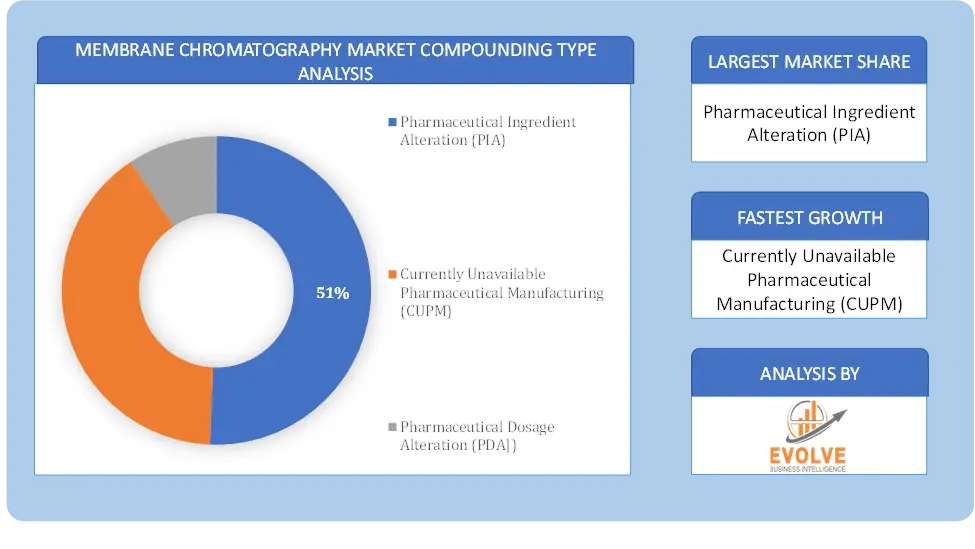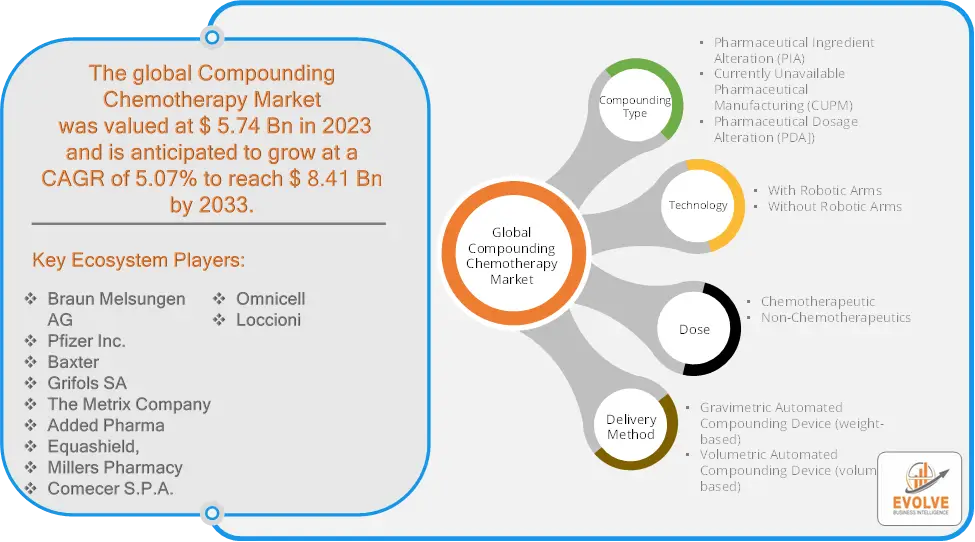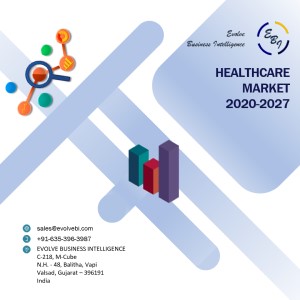Compounding Chemotherapy Market Analysis and Global Forecast 2023-2033
$ 1,390.00 – $ 5,520.00Price range: $ 1,390.00 through $ 5,520.00
Compounding Chemotherapy Market Research Report: By Compounding Type (Pharmaceutical Ingredient Alteration (PIA), Currently Unavailable Pharmaceutical Manufacturing (CUPM), Pharmaceutical Dosage Alteration (PDA])), By Technology (With Robotic Arms, Without Robotic Arms), By Dose (Chemotherapeutic, Non-Chemotherapeutics), By Delivery Method (Gravimetric Automated Compounding Device (weight-based), Volumetric Automated Compounding Device (volume-based)), and by Region — Forecast till 2033
Page: 106
Compounding Chemotherapy Market Overview
Compounding Chemotherapy Market Size is expected to reach USD 8.41 Billion by 2033. The Compounding Chemotherapy industry size accounted for USD 5.74 Billion in 2023 and is expected to expand at a compound annual growth rate (CAGR) of 5.07% from 2023 to 2033. The compounding chemotherapy market involves the preparation and customization of chemotherapy drugs to meet specific patient needs. It caters to oncology centers, hospitals, and pharmacies that require tailored doses or formulations for cancer treatment. This market includes various services, such as mixing, diluting, and combining drugs to ensure proper dosage and effectiveness. The growth of this market is driven by the increasing incidence of cancer, advances in pharmaceutical technology, and a rising focus on personalized medicine. Key players in this space include specialty pharmacies and compounding centers. Regulations and safety standards play a crucial role in shaping this market.
Global Compounding Chemotherapy Market Synopsis
The COVID-19 pandemic has led to supply chain disruptions leading to supply shortages or lower demand in the Compounding Chemotherapy market. The travel restrictions and social-distancing measures have resulted in a sharp drop in consumer and business spending and this pattern is to continue for some time. The end-user trend and preferences have changed due to the pandemic and have resulted in manufacturers, developers, and service providers to adopt various strategies to stabilize the company.
Global Compounding Chemotherapy Market Dynamics
The major factors that have impacted the growth of Compounding Chemotherapy are as follows:
Drivers:
⮚ Advancements in Pharmaceutical Technology
Technological advancements in drug formulation and delivery systems have significantly impacted the compounding chemotherapy market. Innovations in drug compounding techniques, such as more precise mixing and diluting methods, have improved the efficacy and safety of compounded chemotherapy drugs.
Restraint:
- High Costs and Investment Requirements
Setting up and maintaining a compounding pharmacy requires substantial investment in specialized equipment, facilities, and trained personnel. The costs associated with these investments can be prohibitive, particularly for smaller or new market entrants. Additionally, ongoing operational costs and the need for continuous staff training to comply with evolving standards can strain financial resources.
Opportunity:
⮚ Technological Advancements
Innovations in pharmaceutical technology, such as advanced compounding equipment and automation, create opportunities for improving the efficiency and accuracy of drug preparation. Enhanced technology can lead to better quality control, reduced error rates, and more consistent formulations, thus expanding the potential applications and appeal of compounded chemotherapy drugs.
Compounding Chemotherapy Market Segment Overview
By Compounding Type
 Based on the Compounding Type, the market is segmented based on Pharmaceutical Ingredient Alteration (PIA), Currently Unavailable Pharmaceutical Manufacturing (CUPM), Pharmaceutical Dosage Alteration (PDA]. Pharmaceutical Ingredient Alteration (PIA) dominates over Currently Unavailable Pharmaceutical Manufacturing (CUPM) and Pharmaceutical Dosage Alteration (PDA) due to its critical role in customizing drug formulations to meet specific patient needs and ensure effectiveness.
Based on the Compounding Type, the market is segmented based on Pharmaceutical Ingredient Alteration (PIA), Currently Unavailable Pharmaceutical Manufacturing (CUPM), Pharmaceutical Dosage Alteration (PDA]. Pharmaceutical Ingredient Alteration (PIA) dominates over Currently Unavailable Pharmaceutical Manufacturing (CUPM) and Pharmaceutical Dosage Alteration (PDA) due to its critical role in customizing drug formulations to meet specific patient needs and ensure effectiveness.
By Technology
Based on Technology, the market has been divided into With Robotic Arms, Without Robotic Arms), By Dose (Chemotherapeutic, Non-Chemotherapeutics. technologies With Robotic Arms dominate over those Without Robotic Arms due to their advanced precision and efficiency in compounding, which is crucial for ensuring the accurate preparation of chemotherapy doses.
By Dose
Based on the Dose, the market has been divided into Chemotherapeutic, Non-Chemotherapeutics. Chemotherapeutic doses dominate over Non-Chemotherapeutic doses due to the higher demand for customized chemotherapy solutions specifically tailored to cancer treatment.
By Delivery Method
Based on Delivery Method, the market has been divided into Gravimetric Automated Compounding Device (weight-based), Volumetric Automated Compounding Device (volume-based). Gravimetric Automated Compounding Devices (weight-based) tend to dominate over Volumetric Automated Compounding Devices (volume-based) due to their greater precision in measuring and mixing drugs, which is crucial for accurate and safe chemotherapy preparation.
Global Compounding Chemotherapy Market Regional Analysis
Based on region, the market has been divided into North America, Europe, Asia-Pacific, the Middle East & Africa, and Latin America. The area of North America is anticipated to dominate the market for the usage of Compounding Chemotherapy, followed by those in Asia-Pacific and Europe.
Compounding Chemotherapy North America Market
The North American region holds a dominant position in the Compounding Chemotherapy market. The market for compounding chemotherapy in America has emerged as the leader and is growing at an incredible rate. The industry in the United States gains from the widespread focus on creating modern healthcare procedures and improving cancer therapies. The aging population, which is more susceptible to different types of cancer, is another factor driving the market value. There will be 24% more elderly individuals in the US by 2060 than there are now, predicts the Population Reference Bureau. These numbers ensure that the need for compounded chemotherapy will not go away in the years to come.
Compounding Chemotherapy Asia Pacific Market
The Asia-Pacific region is witnessing rapid growth and emerging as a significant market for the Compounding Chemotherapy industry. It is projected that the Asia Pacific compounding chemotherapy market will expand at a substantial clip. Asia-Pacific’s sales of compound chemotherapy are broken down into Japan, Australia, South Korea, China, and India. The healthcare industry has tremendous growth potential in the region since governments in many countries, especially in China and India, provide financing for ongoing research and development activities in this field.
Competitive Landscape
The competitive landscape includes key players (tier 1, tier 2, and local) having a presence across the globe. Companies such as Braun Melsungen AG, Pfizer Inc., Baxter, Grifols SA, and The Metrix Company are some of the leading players in the global Compounding Chemotherapy Industry. These players have adopted partnership, acquisition, expansion, and new product development, among others as their key strategies.
Key Market Players:
- Braun Melsungen AG
- Pfizer Inc.
- Baxter
- Grifols SA
- The Metrix Company
- Added Pharma
- Equashield, Millers Pharmacy
- Comecer S.P.A.
- Omnicell
- Loccioni
Key Development:
March 2021: The establishment of Revelation Pharma Corp. has been announced by Osceola Capital and seasoned businessman Jacob Beckel to investigate funding and cooperative arrangements in the pharmaceutical compounding sector.
Scope of the Report
Global Compounding Chemotherapy Market, by Compounding Type
- Pharmaceutical Ingredient Alteration (PIA)
- Currently Unavailable Pharmaceutical Manufacturing (CUPM)
- Pharmaceutical Dosage Alteration (PDA])
Global Compounding Chemotherapy Market, by Technology
- With Robotic Arms
- Without Robotic Arms
Global Compounding Chemotherapy Market, by Dose
- Chemotherapeutic
- Non-Chemotherapeutics
Global Compounding Chemotherapy Market, by Delivery Method
- Gravimetric Automated Compounding Device (weight-based)
- Volumetric Automated Compounding Device (volume-based)
Global Compounding Chemotherapy Market, by Region
- North America
- US
- Canada
- Mexico
- Europe
- UK
- Germany
- France
- Italy
- Spain
- Benelux
- Nordic
- Rest of Europe
- Asia Pacific
- China
- Japan
- South Korea
- Indonesia
- Austalia
- Malaysia
- India
- Rest of Asia Pacific
- South America
- Brazil
- Argentina
- Rest of South America
- Middle East & Africa
- Saudi Arabia
- UAE
- Egypt
- South Africa
- Rest of Middle East & Africa
| Parameters | Indicators |
|---|---|
| Market Size | 2033: $8.41 Billion |
| CAGR | 5.07% CAGR (2023-2033) |
| Base year | 2022 |
| Forecast Period | 2023-2033 |
| Historical Data | 2021 |
| Report Coverage | Revenue Forecast, Competitive Landscape, Growth Factors, and Trends |
| Key Segmentations | Compounding Type, Technology, Dose , Delivery Method |
| Geographies Covered | North America, Europe, Asia-Pacific, Latin America, Middle East, Africa |
| Key Vendors | Braun Melsungen AG, Pfizer Inc., Baxter, Grifols SA, The Metrix Company, Added Pharma, Equashield, Millers Pharmacy, Comecer S.P.A., Omnicell, Loccioni |
| Key Market Opportunities | Opioid scarcity |
| Key Market Drivers | Technical Advances Cutting-Edge Strategie |
REPORT CONTENT BRIEF:
- High-level analysis of the current and future Compounding Chemotherapy Industry trends and opportunities
- Detailed analysis of current market drivers, restraining factors, and opportunities analysis in the future
- Historical market size for the year 2021, and forecast from 2023 to 2033
- Compounding Chemotherapy market share analysis for each segment
- Competitor analysis with a comprehensive insight into its product segment, financial strength, and strategies adopted.
- Identifies key strategies adopted by the key players including new product development, mergers and acquisitions, joint ventures, collaborations, and partnerships.
- To identify and understand the various factors involved in the global Compounding Chemotherapy market affected by the pandemic
- To provide year-on-year growth from 2022 to 2033
- To provide short-term, long-term, and overall CAGR comparison from 2022 to 2033.
- Provide Total Addressable Market (TAM) for the Global Compounding Chemotherapy Market.
Press Release

Global Pharmaceutical Manufacturing Market to Reach $1.38 Trillion by 2035 with 7.35% CAGR, New Research Shows

The Global Mammography Market Is Estimated To Record a CAGR of Around 10.29% During The Forecast Period

Glue Stick Market to Reach USD 2.35 Billion by 2034

Podiatry Service Market to Reach USD 11.88 Billion by 2034

Microfluidics Technology Market to Reach USD 32.58 Billion by 2034

Ferric Chloride Market to Reach USD 10.65 Billion by 2034

Family Practice EMR Software Market to Reach USD 21.52 Billion by 2034

Electric Hairbrush Market to Reach USD 15.95 Billion by 2034

Daily Bamboo Products Market to Reach USD 143.52 Billion by 2034

Cross-border E-commerce Logistics Market to Reach USD 112.65 Billion by 2034
Frequently Asked Questions (FAQ)
What is the study period of this market?
The study period of the global Compounding Chemotherapy market is 2022- 2033
What are the 10 Years CAGR (2023 to 2033) of the global Compounding Chemotherapy market?
The global Compounding Chemotherapy market is growing at a CAGR of ~5.07% over the next 10 years
Which region has the highest growth rate in the market of Compounding Chemotherapy?
Asia Pacific is expected to register the highest CAGR during 2023-2033
Which region accounted for the largest share of the market of Compounding Chemotherapy?
North America holds the largest share in 2022
Major Key Players in the Market of Compounding Chemotherapy?
Braun Melsungen AG, Pfizer Inc., Baxter, Grifols SA, The Metrix Company, Added Pharma, Equashield, Millers Pharmacy, Comecer S.P.A., Omnicell, and Loccioni are the major companies operating in the Compounding Chemotherapy Industry
Do you offer Post Sale Support?
Yes, we offer 16 hours of analyst support to solve the queries
Do you deliver sections of a report?
Yes, we do provide regional as well as country-level reports. Other than this we also provide a sectional report. Please get in contact with our sales representatives
Table of Content
Chapter 1. Executive Summary Chapter 2. Scope of The Study 2.1. Market Definition 2.2. Scope of The Study 2.2.1. Objectives of Report Chapter 3. Evolve BI Methodology Chapter 4. Market Insights and Trends 4.1. Supply/ Value Chain Analysis 4.2. Porter’s Five Forces Analysis 4.2.1. Threat of New Entrants 4.2.2. Bargaining Power of Buyers 4.2.3. Bargaining Power of Suppliers 4.2.4. Threat of Substitutes 4.2.5. Industry Rivalry 4.3. Impact of COVID-19 on Compounding Chemotherapy Market 4.3.1. Impact on Market Size 4.3.2. Delivery Methodr Trend, Preferences and Budget Impact 4.3.3. Regulatory Framework/Government Policies 4.3.4. Key Players Strategy to Tackle Negative Impact 4.3.5. Opportunity Window Chapter 5. Market Dynamics 5.1. Introduction 5.2. DRO Analysis 5.2.1. Drivers 5.2.2. Restraints 5.2.3. Opportunities Chapter 6. Global Compounding Chemotherapy Market, By Compounding Type 6.1. Introduction 6.2. Pharmaceutical Ingredient Alteration (PIA) 6.3. Currently Unavailable Pharmaceutical Manufacturing (CUPM) 6.4. Pharmaceutical Dosage Alteration (PDA]) Chapter 7. Global Compounding Chemotherapy Market, By Technology 7.1. Introduction 7.2. With Robotic Arms 7.3. Without Robotic Arms Chapter 8. Global Compounding Chemotherapy Market, By Dose 8.1. Introduction 8.2. Chemotherapeutic 8.3. Non-Chemotherapeutics Chapter 9. Global Compounding Chemotherapy Market, By Delivery Method 9.1. Introduction 9.2. Gravimetric Automated Compounding Device (weight-based) 9.3. Volumetric Automated Compounding Device (volume-based) Chapter 10. Global Compounding Chemotherapy Market, By Region 10.1. Introduction 10.2. North America 10.2.1. Introduction 10.2.2. Driving Factors, Opportunity Analyzed and Key Trends 10.2.3. Market Size and Forecast, By Country, 2020 - 2028 10.2.4. Market Size and Forecast, By Compounding Type, 2020 - 2028 10.2.5. Market Size and Forecast, By Technology, 2020 - 2028 10.2.6. Market Size and Forecast, By Dose, 2020 – 2028 10.2.7. Market Size and Forecast, By Delivery Methodr, 2020 – 2028 10.2.8. US 10.2.8.1. Introduction 10.2.8.2. Driving Factors, Opportunity Analyzed and Key Trends 10.2.8.3. Market Size and Forecast, By Compounding Type, 2020 - 2028 10.2.8.4. Market Size and Forecast, By Technology, 2020 - 2028 10.2.8.5. Market Size and Forecast, By Dose, 2020 – 2028 10.2.8.6. Market Size and Forecast, By Delivery Methodr, 2020 - 2028 10.2.9. Canada 10.2.9.1. Introduction 10.2.9.2. Driving Factors, Opportunity Analyzed and Key Trends 10.2.9.3. Market Size and Forecast, By Compounding Type, 2020 - 2028 10.2.9.4. Market Size and Forecast, By Technology, 2020 - 2028 10.2.9.5. Market Size and Forecast, By Dose, 2020 – 2028 10.2.9.6. Market Size and Forecast, By Delivery Methodr, 2020 - 2028 10.3. Europe 10.3.1. Introduction 10.3.2. Driving Factors, Opportunity Analyzed and Key Trends 10.3.3. Market Size and Forecast, By Country, 2020 - 2028 10.3.4. Market Size and Forecast, By Compounding Type, 2020 - 2028 10.3.5. Market Size and Forecast, By Technology, 2020 - 2028 10.3.6. Market Size and Forecast, By Dose, 2020 – 2028 10.3.7. Market Size and Forecast, By Delivery Methodr, 2020 – 2028 10.3.8. Germany 10.3.8.1. Introduction 10.3.8.2. Driving Factors, Opportunity Analyzed and Key Trends 10.3.8.3. Market Size and Forecast, By Compounding Type, 2020 - 2028 10.3.8.4. Market Size and Forecast, By Technology, 2020 - 2028 10.3.8.5. Market Size and Forecast, By Dose, 2020 – 2028 10.3.8.6. Market Size and Forecast, By Delivery Methodr, 2020 - 2028 10.3.9. France 10.3.9.1. Introduction 10.3.9.2. Driving Factors, Opportunity Analyzed and Key Trends 10.3.9.3. Market Size and Forecast, By Compounding Type, 2020 - 2028 10.3.9.4. Market Size and Forecast, By Technology, 2020 - 2028 10.3.9.5. Market Size and Forecast, By Dose, 2020 – 2028 10.3.9.6. Market Size and Forecast, By Delivery Methodr, 2020 - 2028 10.3.10. UK 10.3.10.1. Introduction 10.3.10.2. Driving Factors, Opportunity Analyzed and Key Trends 10.3.10.3. Market Size and Forecast, By Compounding Type, 2020 - 2028 10.3.10.4. Market Size and Forecast, By Technology, 2020 - 2028 10.3.10.5. Market Size and Forecast, By Dose, 2020 – 2028 10.3.10.6. Market Size and Forecast, By Delivery Methodr, 2020 - 2028 10.3.11. Italy 10.3.11.1. Introduction 10.3.11.2. Driving Factors, Opportunity Analyzed and Key Trends 10.3.11.3. Market Size and Forecast, By Compounding Type, 2020 - 2028 10.3.11.4. Market Size and Forecast, By Technology, 2020 - 2028 10.3.11.5. Market Size and Forecast, By Dose, 2020 – 2028 10.3.11.6. Market Size and Forecast, By Delivery Methodr, 2020 - 2028 10.3.12. Rest of Europe 10.3.12.1. Introduction 10.3.12.2. Driving Factors, Opportunity Analyzed and Key Trends 10.3.12.3. Market Size and Forecast, By Compounding Type, 2020 - 2028 10.3.12.4. Market Size and Forecast, By Technology, 2020 - 2028 10.3.12.5. Market Size and Forecast, By Dose, 2020 – 2028 10.3.12.6. Market Size and Forecast, By Delivery Methodr, 2020 - 2028 10.4. Asia-Pacific 10.4.1. Introduction 10.4.2. Driving Factors, Opportunity Analyzed and Key Trends 10.4.3. Market Size and Forecast, By Country, 2020 - 2028 10.4.4. Market Size and Forecast, By Compounding Type, 2020 - 2028 10.4.5. Market Size and Forecast, By Technology, 2020 - 2028 10.4.6. Market Size and Forecast, By Dose, 2020 – 2028 10.4.7. Market Size and Forecast, By Delivery Methodr, 2020 - 2028 10.4.8. China 10.4.8.1. Introduction 10.4.8.2. Driving Factors, Opportunity Analyzed and Key Trends 10.4.8.3. Market Size and Forecast, By Compounding Type, 2020 - 2028 10.4.8.4. Market Size and Forecast, By Technology, 2020 - 2028 10.4.8.5. Market Size and Forecast, By Dose, 2020 – 2028 10.4.8.6. Market Size and Forecast, By Delivery Methodr, 2020 - 2028 10.4.9. India 10.4.9.1. Introduction 10.4.9.2. Driving Factors, Opportunity Analyzed and Key Trends 10.4.9.3. Market Size and Forecast, By Compounding Type, 2020 - 2028 10.4.9.4. Market Size and Forecast, By Technology, 2020 - 2028 10.4.9.5. Market Size and Forecast, By Dose, 2020 – 2028 10.4.9.6. Market Size and Forecast, By Delivery Methodr, 2020 - 2028 10.4.10. Japan 10.4.10.1. Introduction 10.4.10.2. Driving Factors, Opportunity Analyzed and Key Trends 10.4.10.3. Market Size and Forecast, By Compounding Type, 2020 - 2028 10.4.10.4. Market Size and Forecast, By Technology, 2020 - 2028 10.4.10.5. Market Size and Forecast, By Dose, 2020 – 2028 10.4.10.6. Market Size and Forecast, By Delivery Methodr, 2020 - 2028 10.4.11. South Korea 10.4.11.1. Introduction 10.4.11.2. Driving Factors, Opportunity Analyzed and Key Trends 10.4.11.3. Market Size and Forecast, By Compounding Type, 2020 - 2028 10.4.11.4. Market Size and Forecast, By Technology, 2020 - 2028 10.4.11.5. Market Size and Forecast, By Dose, 2020 – 2028 10.4.11.6. Market Size and Forecast, By Delivery Methodr, 2020 - 2028 10.4.12. Rest of Asia-Pacific 10.4.12.1. Introduction 10.4.12.2. Driving Factors, Opportunity Analyzed and Key Trends 10.4.12.3. Market Size and Forecast, By Compounding Type, 2020 - 2028 10.4.12.4. Market Size and Forecast, By Technology, 2020 - 2028 10.4.12.5. Market Size and Forecast, By Dose, 2020 – 2028 10.4.12.6. Market Size and Forecast, By Delivery Methodr, 2020 - 2028 10.5. Rest of The World (RoW) 10.5.1. Introduction 10.5.2. Driving Factors, Opportunity Analyzed and Key Trends 10.5.3. Market Size and Forecast, By Compounding Type, 2020 - 2028 10.5.4. Market Size and Forecast, By Technology, 2020 - 2028 10.5.5. Market Size and Forecast, By Dose, 2020 – 2028 10.5.6. Market Size and Forecast, By Delivery Methodr, 2020 - 2028 10.5.7. Market Size and Forecast, By Region, 2020 - 2028 10.5.8. South America 10.5.8.1. Introduction 10.5.8.2. Driving Factors, Opportunity Analyzed and Key Trends 10.5.8.3. Market Size and Forecast, By Compounding Type, 2020 - 2028 10.5.8.4. Market Size and Forecast, By Technology, 2020 - 2028 10.5.8.5. Market Size and Forecast, By Dose, 2020 – 2028 10.5.8.6. Market Size and Forecast, By Delivery Methodr, 2020 - 2028 10.5.9. Middle East & Africa 10.5.9.1. Introduction 10.5.9.2. Driving Factors, Opportunity Analyzed and Key Trends 10.5.9.3. Market Size and Forecast, By Compounding Type, 2020 - 2028 10.5.9.4. Market Size and Forecast, By Technology, 2020 - 2028 10.5.9.5. Market Size and Forecast, By Dose, 2020 – 2028 10.5.9.6. Market Size and Forecast, By Delivery Methodr, 2020 - 2028 Chapter 11. Competitive Landscape 11.1. Introduction 11.2. Vendor Share Analysis, 2020/Key Players Positioning, 2020 Chapter 12. Company Profiles 12.1. Braun Melsungen AG 12.1.1. Business Overview 12.1.2. Financial Analysis 12.1.3. Product Portfolio 12.1.4. Recent Development and Strategies Adopted 12.1.5. SWOT Analysis 12.2. Pfizer Inc. 12.2.1. Business Overview 12.2.2. Financial Analysis 12.2.3. Product Portfolio 12.2.4. Recent Development and Strategies Adopted 12.2.5. SWOT Analysis 12.3. Baxter 12.3.1. Business Overview 12.3.2. Financial Analysis 12.3.3. Product Portfolio 12.3.4. Recent Development and Strategies Adopted 12.3.5. SWOT Analysis 12.4. Grifols SA 12.4.1. Business Overview 12.4.2. Financial Analysis 12.4.3. Product Portfolio 12.4.4. Recent Development and Strategies Adopted 12.4.5. SWOT Analysis 12.5. The Metrix Company 12.5.1. Business Overview 12.5.2. Financial Analysis 12.5.3. Product Portfolio 12.5.4. Recent Development and Strategies Adopted 12.5.5. SWOT Analysis 12.6. Added Pharma 12.6.1. Business Overview 12.6.2. Financial Analysis 12.6.3. Product Portfolio 12.6.4. Recent Development and Strategies Adopted 12.6.5. SWOT Analysis 12.7. Equashield, Millers Pharmacy 12.7.1. Business Overview 12.7.2. Financial Analysis 12.7.3. Product Portfolio 12.7.4. Recent Development and Strategies Adopted 12.7.5. SWOT Analysis 12.8. Comecer S.P.A. 12.8.1. Business Overview 12.8.2. Financial Analysis 12.8.3. Product Portfolio 12.8.4. Recent Development and Strategies Adopted 12.8.5. SWOT Analysis 12.9. Omnicell 12.9.1. Business Overview 12.9.2. Financial Analysis 12.9.3. Product Portfolio 12.9.4. Recent Development and Strategies Adopted 12.9.5. SWOT Analysis 12.10. Loccioni 12.10.1. Business Overview 12.10.2. Financial Analysis 12.10.3. Product Portfolio 12.10.4. Recent Development and Strategies Adopted 12.10.5. SWOT Analysis Chapter 13. Key Takeaways
Connect to Analyst
Research Methodology







